Minnella, Joseph D.; Ouellet, Mathieu; Klein, Amelia R.; Bassett, Lee C.
Single-gate, multipartite entanglement on a room-temperature quantum register Journal Article Forthcoming
In: arXiv, Forthcoming.
Abstract | Links | BibTeX | Tags: diamond NV center, forthcoming, Quantum Control, quantum sensing
@article{Minnella2025,
title = {Single-gate, multipartite entanglement on a room-temperature quantum register},
author = {Joseph D. Minnella and Mathieu Ouellet and Amelia R. Klein and Lee C. Bassett},
url = {https://arxiv.org/abs/2508.08465},
year = {2025},
date = {2025-08-11},
urldate = {2025-08-11},
journal = {arXiv},
abstract = {Multipartite entanglement is an essential aspect of quantum systems, needed to execute quantum algorithms, implement error correction, and achieve quantum-enhanced sensing. In solid-state quantum registers such nitrogen-vacancy (NV) centers in diamond, entangled states are typically created using sequential, pairwise gates between the central electron and individual nuclear qubits. This sequential approach is slow and suffers from crosstalk errors. Here, we demonstrate a parallelized multi-qubit entangling gate to generate a four-qubit GHZ state using a room-temperature NV center in only 14.8 s 10 times faster than using sequences of two-qubit gates. The entangled states are verified by measuring multiple quantum coherences. Two-qubit entangling gates have an average fidelity of 0.96(1), and the four-qubit parallel gate has a fidelity of 0.92(4), whereas the sequential four-qubit gate fidelity is only 0.69(3). The approach is generalizable to other solid-state platforms, and it lays the foundation for scalable generation and control of entanglement in practical devices. },
keywords = {diamond NV center, forthcoming, Quantum Control, quantum sensing},
pubstate = {forthcoming},
tppubtype = {article}
}
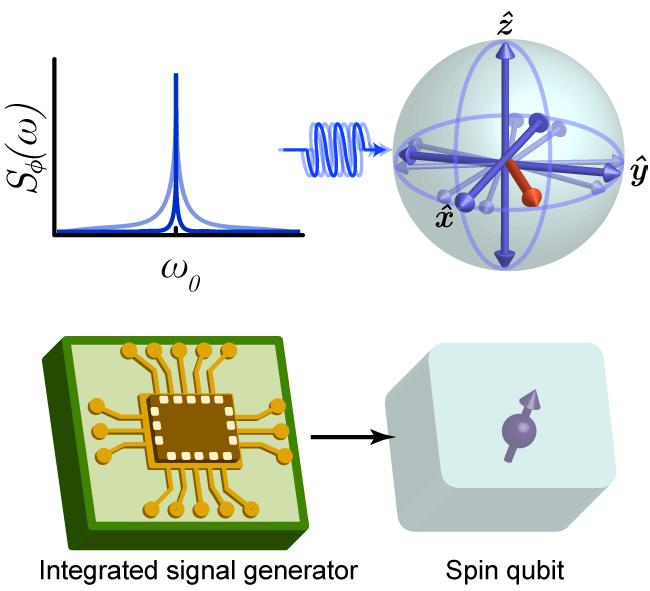
Huang, Tzu-Yung; Hopper, David A.; Omirzakhov, Kaisarbek; Idjadi, Mohamad Hossein; Breitweiser, S. Alexander; Aflatouni, Firooz; Bassett, Lee C.
Electronic Noise Considerations for Designing Integrated Solid-State Quantum Memories Journal Article
In: Advanced Quantum Technologies, pp. 2400472, 2025.
Abstract | Links | BibTeX | Tags: diamond NV center, Quantum Control, spin readout
@article{Huang2025,
title = {Electronic Noise Considerations for Designing Integrated Solid-State Quantum Memories},
author = {Tzu-Yung Huang and David A. Hopper and Kaisarbek Omirzakhov and Mohamad Hossein Idjadi and S. Alexander Breitweiser and Firooz Aflatouni and Lee C. Bassett},
url = {https://onlinelibrary.wiley.com/doi/10.1002/qute.202400472#
https://arxiv.org/abs/2501.00683},
year = {2025},
date = {2025-02-06},
urldate = {2025-02-06},
journal = {Advanced Quantum Technologies},
pages = {2400472},
abstract = {As quantum networks expand and are deployed outside research laboratories, a need arises to design and integrate compact control electronics for each memory node. It is essential to understand the performance requirements for such systems, especially concerning tolerable levels of noise, since these specifications dramatically affect a system's design complexity and cost. Here, using an approach that can be easily generalized across quantum-hardware platforms, a case study based on nitrogen-vacancy (NV) centers in diamond is presented. The effects of phase noise and timing jitter in the control system in conjunction are modeled and experimentally verified with the spin qubit's environmental noise. The impact of different phase noise characteristics on the fidelity of dynamical decoupling sequences is also considered. The results demonstrate a procedure to specify design requirements for integrated quantum control signal generators for solid-state spin qubits, depending on their coherence time, intrinsic noise spectrum, and required fidelity.},
keywords = {diamond NV center, Quantum Control, spin readout},
pubstate = {published},
tppubtype = {article}
}
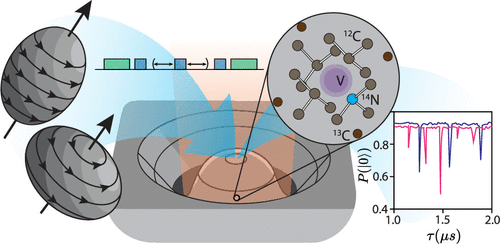
Breitweiser, S. Alex; Ouellet, Mathieu; Huang, Tzu-Yung; Taminiau, Tim H.; Bassett, Lee C.
Quadrupolar resonance spectroscopy of individual nuclei using a room-temperature quantum sensor Journal Article
In: Nano Letters, vol. 24, iss. 51, pp. 16253-16260, 2024.
Abstract | Links | BibTeX | Tags: diamond NV center, NQR spectroscopy, point defects, quantum sensing
@article{Breitweiser2024,
title = {Quadrupolar resonance spectroscopy of individual nuclei using a room-temperature quantum sensor},
author = {S. Alex Breitweiser and Mathieu Ouellet and Tzu-Yung Huang and Tim H. Taminiau and Lee C. Bassett},
url = {https://pubs.acs.org/doi/abs/10.1021/acs.nanolett.4c04112
https://arxiv.org/abs/2405.14859},
year = {2024},
date = {2024-12-12},
urldate = {2024-12-12},
journal = {Nano Letters},
volume = {24},
issue = {51},
pages = {16253-16260},
abstract = {Nuclear quadrupolar resonance (NQR) spectroscopy reveals chemical bonding patterns in materials and molecules through the unique coupling between nuclear spins and local fields. However, traditional NQR techniques require macroscopic ensembles of nuclei to yield a detectable signal, which obscures molecule-to-molecule variations. Solid-state spin qubits, such as the nitrogen-vacancy (NV) center in diamond, facilitate the detection and control of individual nuclei through their local magnetic couplings. Here, we use NV centers to perform NQR spectroscopy on their associated nitrogen-14 (14N) nuclei at room temperature. In mapping the nuclear quadrupolar Hamiltonian, we resolve minute variations between individual nuclei. The measurements reveal correlations between the Hamiltonian parameters associated with the NV center’s electronic and nuclear spin states, as well as a previously unreported symmetry-breaking quadrupolar term. We further design pulse sequences to initialize, read out, and control the quantum evolution of the 14N nuclear state using the nuclear quadrupolar Hamiltonian.},
keywords = {diamond NV center, NQR spectroscopy, point defects, quantum sensing},
pubstate = {published},
tppubtype = {article}
}

Klein, Amelia R.; Engheta, Nader; Bassett, Lee C.
Designing metasurface optical interfaces for solid-state qubits using many-body adjoint shape optimization Journal Article
In: Optics Express, vol. 32, iss. 22, pp. 38504-38515, 2024.
Abstract | Links | BibTeX | Tags: diamond fabrication, diamond NV center, Nanophotonics, photoluminescence
@article{Klein2024,
title = {Designing metasurface optical interfaces for solid-state qubits using many-body adjoint shape optimization},
author = {Amelia R. Klein and Nader Engheta and Lee C. Bassett},
url = {https://opg.optica.org/oe/fulltext.cfm?uri=oe-32-22-38504&id=561330
https://arxiv.org/abs/2406.08212},
doi = {10.1364/OE.522501},
year = {2024},
date = {2024-10-09},
urldate = {2024-10-09},
journal = {Optics Express},
volume = {32},
issue = {22},
pages = {38504-38515},
abstract = {We present a general strategy for the inverse design of metasurfaces composed of elementary shapes. We use it to design a structure that collects and collimates light from nitrogen-vacancy centers in diamond. Such metasurfaces constitute scalable optical interfaces for solid-state qubits, enabling efficient photon coupling into optical fibers and eliminating free-space collection optics. The many-body shape optimization strategy is a practical alternative to topology optimization that explicitly enforces material and fabrication constraints throughout the optimization, while still achieving high performance. The metasurface is easily adaptable to other solid-state qubits, and the optimization method is broadly applicable to fabrication-constrained photonic design problems.},
keywords = {diamond fabrication, diamond NV center, Nanophotonics, photoluminescence},
pubstate = {published},
tppubtype = {article}
}
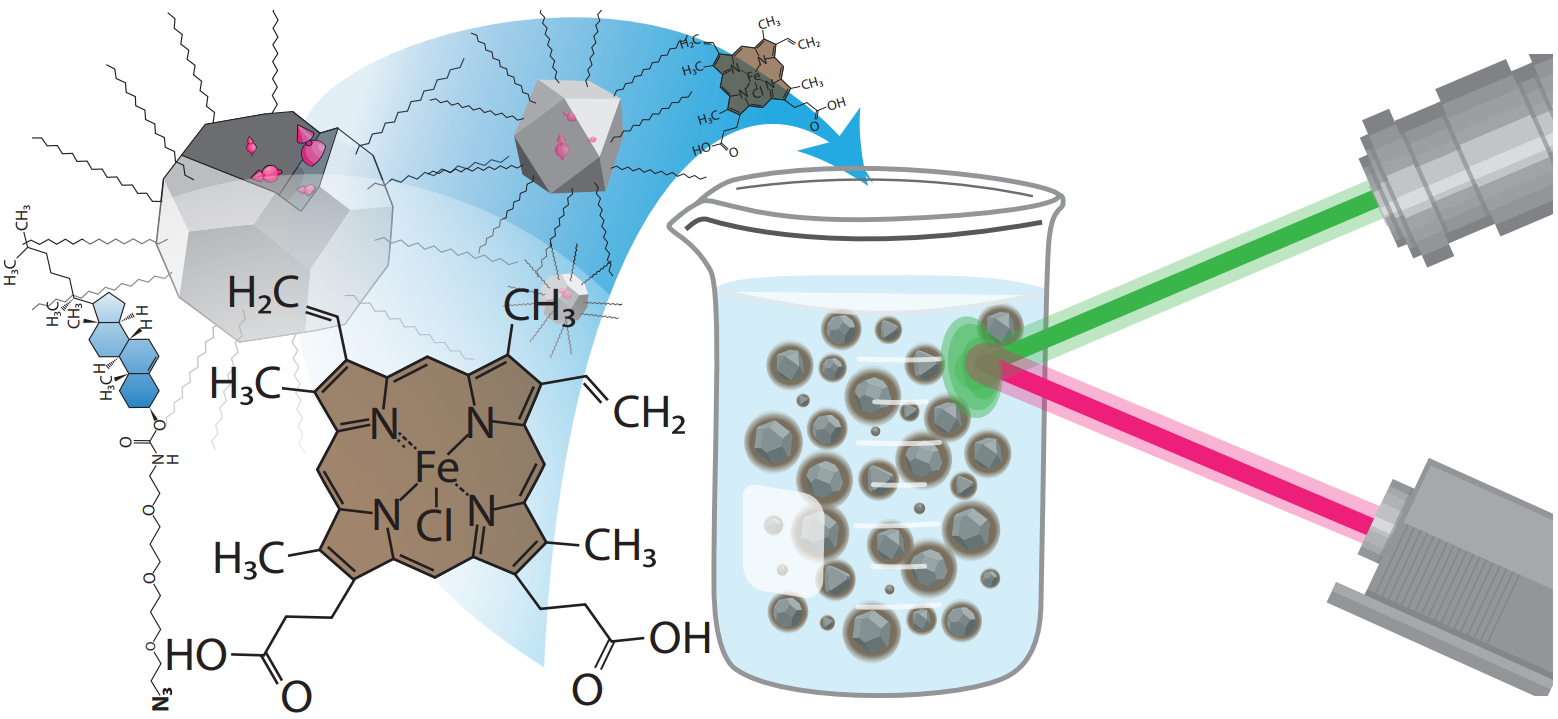
Shulevitz, Henry J.; Amirshaghaghi, Ahmad; Ouellet, Mathieu; Brustoloni, Caroline; Yang, Shengsong; Ng, Jonah J.; Huang, Tzu-Yung; Jishkariani, Davit; Murray, Christopher B.; Tsourkas, Andrew; Kagan, Cherie R.; Bassett, Lee C.
Nanodiamond emulsions for enhanced quantum sensing and click-chemistry conjugation Journal Article
In: ACS Applied Nano Materials, vol. 7, iss. 13, pp. 15334-15343, 2024.
Abstract | Links | BibTeX | Tags: colloidal nanocrystals, diamond NV center, nanodiamonds, spin relaxometry
@article{Shulevitz2024,
title = {Nanodiamond emulsions for enhanced quantum sensing and click-chemistry conjugation},
author = {Henry J. Shulevitz and Ahmad Amirshaghaghi and Mathieu Ouellet and Caroline Brustoloni and Shengsong Yang and Jonah J. Ng and Tzu-Yung Huang and Davit Jishkariani and Christopher B. Murray and Andrew Tsourkas and Cherie R. Kagan and Lee C. Bassett},
url = {https://pubs.acs.org/doi/abs/10.1021/acsanm.4c01699
https://arxiv.org/abs/2311.16530},
doi = {10.1021/acsanm.4c01699},
year = {2024},
date = {2024-06-29},
urldate = {2024-06-29},
journal = {ACS Applied Nano Materials},
volume = {7},
issue = {13},
pages = {15334-15343},
abstract = {Nanodiamonds containing nitrogen-vacancy (NV) centers can serve as colloidal quantum sensors of local fields in biological and chemical environments. However, nanodiamond surfaces are challenging to modify without degrading their colloidal stability or the NV center’s optical and spin properties. We present a simple and general method to coat nanodiamonds with a thin emulsion layer that preserves their quantum features, maintains their colloidal stability, and provides functional groups for subsequent cross-linking and click-chemistry conjugation reactions. To demonstrate this technique, we decorated nanodiamonds with combinations of carboxyl- and azide-terminated amphiphiles that enable conjugation using two different strategies. A theoretical model is developed to understand the effect of the emulsion layer on the NV center’s spin lifetime, and T1 relaxometry is employed to quantify the nanodiamonds’ chemical sensitivity to paramagnetic ions. This general approach to nanodiamond surface functionalization will enable advances in quantum nanomedicine and biological sensing.},
keywords = {colloidal nanocrystals, diamond NV center, nanodiamonds, spin relaxometry},
pubstate = {published},
tppubtype = {article}
}
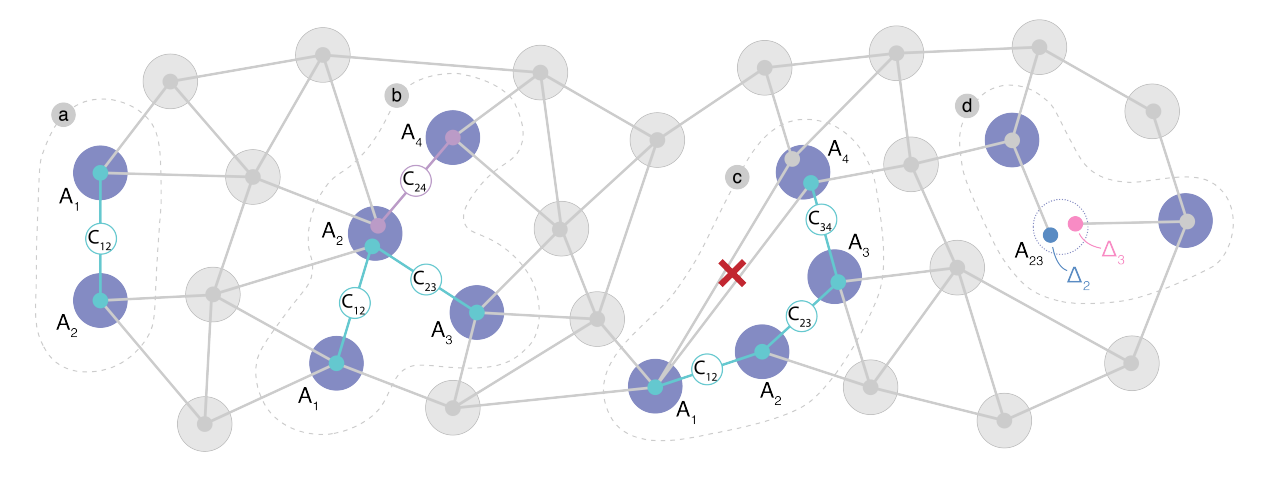
van de Stolpe, G. L.; Kwiatkowski, D. P.; Bradley, C. E.; Randall, J.; Breitweiser, S. A.; Bassett, L. C.; Markham, M.; Twitchen, D. J.; Taminiau, T. H.
Mapping a 50-spin-qubit network through correlated sensing Journal Article
In: Nature Communications , vol. 15, no. 2006, 2024.
Abstract | Links | BibTeX | Tags: complex quantum systems, diamond NV center, network science
@article{vandeStolpe2023,
title = {Mapping a 50-spin-qubit network through correlated sensing},
author = {G.L. van de Stolpe and D. P. Kwiatkowski and C.E. Bradley and J. Randall and S. A. Breitweiser and L. C. Bassett and M. Markham and D.J. Twitchen and T.H. Taminiau},
url = {https://arxiv.org/abs/2307.06939
https://www.nature.com/articles/s41467-024-46075-4},
doi = {10.1038/s41467-024-46075-4},
year = {2024},
date = {2024-03-05},
journal = {Nature Communications },
volume = {15},
number = {2006},
abstract = {Spins associated to optically accessible solid-state defects have emerged as a versatile platform for exploring quantum simulation, quantum sensing and quantum communication. Pioneering experiments have shown the sensing, imaging, and control of multiple nuclear spins surrounding a single electron-spin defect. However, the accessible size and complexity of these spin networks has been constrained by the spectral resolution of current methods. Here, we map a network of 50 coupled spins through high-resolution correlated sensing schemes, using a single nitrogen-vacancy center in diamond. We develop concatenated double-resonance sequences that identify spin-chains through the network. These chains reveal the characteristic spin frequencies and their interconnections with high spectral resolution, and can be fused together to map out the network. Our results provide new opportunities for quantum simulations by increasing the number of available spin qubits. Additionally, our methods might find applications in nano-scale imaging of complex spin systems external to the host crystal.},
keywords = {complex quantum systems, diamond NV center, network science},
pubstate = {published},
tppubtype = {article}
}
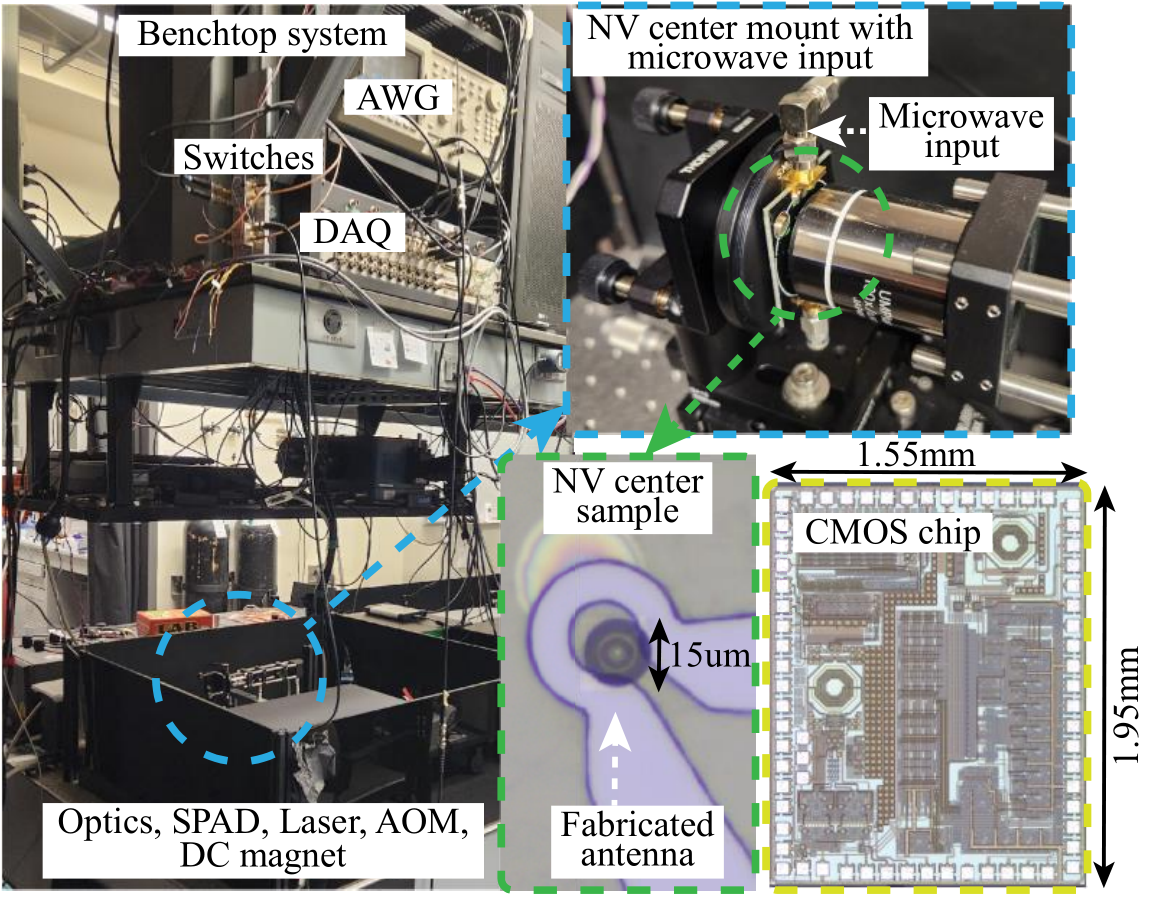
Omirzakhov, Kaisarbek; Idjadi, Mohamad Hossein; Huang, Tzu-Yung; Breitweiser, S. Alex; Hopper, David A.; Bassett, Lee C.; Aflatouni, Firooz
An Integrated Reconfigurable Spin Control System on 180 nm CMOS for Diamond NV Centers Journal Article
In: IEEE Transactions on Microwave Theory and Techniques, pp. 1-12, 2023.
Abstract | Links | BibTeX | Tags: diamond NV center, Quantum Control, spin readout
@article{Omirzakhov2023,
title = {An Integrated Reconfigurable Spin Control System on 180 nm CMOS for Diamond NV Centers},
author = {Kaisarbek Omirzakhov and Mohamad Hossein Idjadi and Tzu-Yung Huang and S. Alex Breitweiser and David A. Hopper and Lee C. Bassett and Firooz Aflatouni},
url = {https://ieeexplore.ieee.org/document/10079193/keywords#keywords},
doi = {10.1109/TMTT.2023.3254600},
year = {2023},
date = {2023-03-23},
journal = {IEEE Transactions on Microwave Theory and Techniques},
pages = {1-12},
abstract = {Solid-state electron spins are key building blocks for emerging applications in quantum information science, including quantum computers, quantum communication links, and quantum sensors. These solid-state spins are mainly controlled using complex microwave pulse sequences, which are typically generated using benchtop electrical instruments. Integration of the required electronics will enable realization of a scalable low-power and compact optically addressable quantum system. Here, we report an integrated reconfigurable quantum control system, which is used to find electron-spin resonance (ESR) frequency and perform Rabi, Ramsey, and Hahn-echo measurements for a nitrogen-vacancy (NV) center spin qubit in diamond. The chip can be programmed to synthesize an RF signal tunable from 1.6 to 2.6 GHz, which is modulated with a sequence of up to 4098 reconfigurable pulses with a pulse width and pulse-to-pulse delay adjustable from 10 ns to 42 ms and 18 ns to 42 ms, respectively, at a resolution of 2.5 ns. The 180-nm CMOS chip is fabricated within a footprint of 3.02 mm 2 and has a power consumption of 80 mW.},
keywords = {diamond NV center, Quantum Control, spin readout},
pubstate = {published},
tppubtype = {article}
}
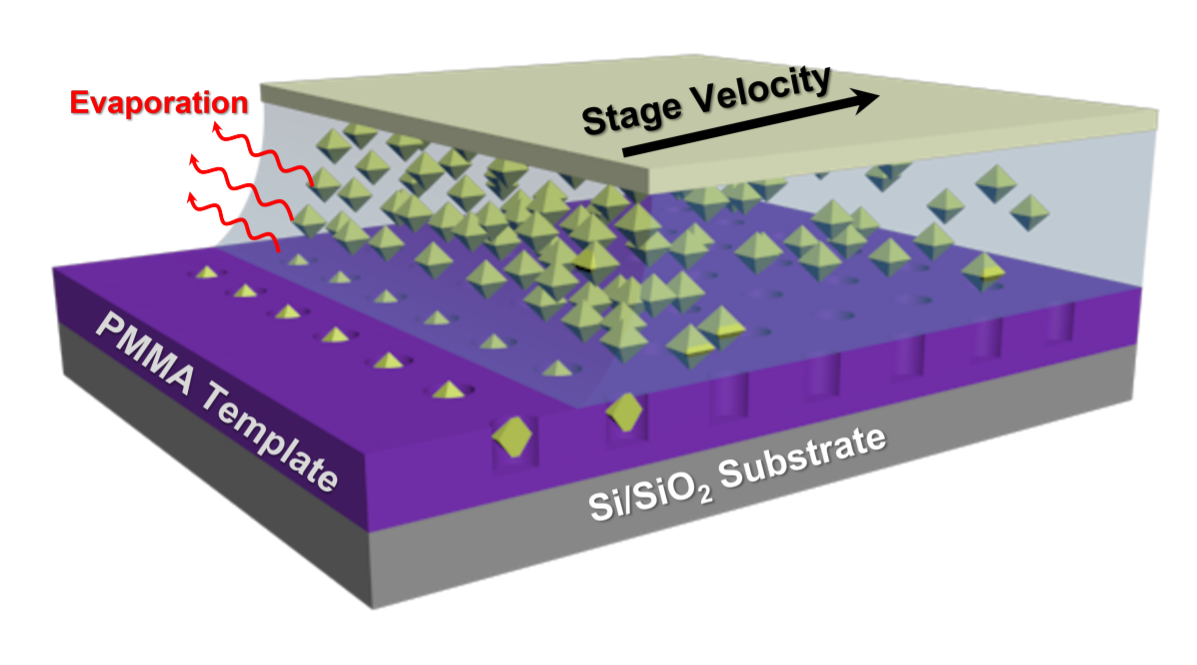
Shulevitz, Henry J.; Huang, Tzu-Yung; Xu, Jun; Neuhaus, Steven; Patel, Raj N.; Lee C. Bassett, Cherie R. Kagan
Template-Assisted Self Assembly of Fluorescent Nanodiamonds for Scalable Quantum Technologies Journal Article
In: ACS Nano, vol. 16, no. 2, pp. 1847–1856, 2022.
Abstract | Links | BibTeX | Tags: Condensed Matter, diamond NV center, nanodiamond assembly, Nanophotonics
@article{Shulevitz2021,
title = {Template-Assisted Self Assembly of Fluorescent Nanodiamonds for Scalable Quantum Technologies},
author = {Henry J. Shulevitz and Tzu-Yung Huang and Jun Xu and Steven Neuhaus and Raj N. Patel and Lee C. Bassett, Cherie R. Kagan},
url = {https://arxiv.org/abs/2111.14921},
doi = {10.1021/acsnano.1c09839},
year = {2022},
date = {2022-01-13},
journal = {ACS Nano},
volume = {16},
number = {2},
pages = {1847–1856},
abstract = {Milled nanodiamonds containing nitrogen-vacancy (NV) centers provide an excellent platform for sensing applications as they are optically robust, have nanoscale quantum sensitivity, and form colloidal dispersions which enable bottom-up assembly techniques for device integration. However, variations in their size, shape, and surface chemistry limit the ability to position individual nanodiamonds and statistically study properties that affect their optical and quantum characteristics. Here, we present a scalable strategy to form ordered arrays of nanodiamonds using capillary-driven, template-assisted self assembly. This method enables the precise spatial arrangement of isolated nanodiamonds with diameters below 50 nm across millimeter-scale areas. Measurements of over 200 assembled nanodiamonds yield a statistical understanding of their structural, optical, and quantum properties. The NV centers' spin and charge properties are uncorrelated with nanodiamond size, but rather are consistent with heterogeneity in their nanoscale environment. This flexible assembly method, together with improved understanding of the material, will enable the integration of nanodiamonds into future quantum photonic and electronic devices.},
keywords = {Condensed Matter, diamond NV center, nanodiamond assembly, Nanophotonics},
pubstate = {published},
tppubtype = {article}
}

Hopper, D A; Lauigan, J D; Huang, T -Y; Bassett, L C
Real-Time Charge Initialization of Diamond Nitrogen-Vacancy Centers for Enhanced Spin Readout Journal Article
In: Phys. Rev. Applied, vol. 13, pp. 024016, 2020.
Abstract | Links | BibTeX | Tags: diamond NV center, spin readout
@article{Hopper2019,
title = {Real-Time Charge Initialization of Diamond Nitrogen-Vacancy Centers for Enhanced Spin Readout},
author = {D A Hopper and J D Lauigan and T -Y Huang and L C Bassett},
url = {https://arxiv.org/abs/1907.08741
https://journals.aps.org/prapplied/abstract/10.1103/PhysRevApplied.13.024016
https://medium.com/penn-engineering/penn-engineers-ensure-quantum-experiments-get-off-to-the-right-start-bbe6f3382cb},
year = {2020},
date = {2020-02-07},
journal = {Phys. Rev. Applied},
volume = {13},
pages = {024016},
abstract = {Selected as an Editor's Suggestion.
A common impediment to qubit performance is imperfect state initialization. In the case of the diamond nitrogen-vacancy (NV) center, the initialization fidelity is limited by fluctuations in the defect's charge state during optical pumping. Here, we use real-time control to deterministically initialize the NV center's charge state at room temperature. We demonstrate a maximum charge initialization fidelity of 99.4±0.1% and present a quantitative model of the initialization process that allows for systems-level optimization of the spin-readout signal-to-noise ratio. Even accounting for the overhead associated with the initialization sequence, increasing the charge initialization fidelity from the steady-state value of 75% near to unity allows for a factor-of-two speedup in experiments while maintaining the same signal-to-noise-ratio. In combination with high-fidelity readout based on spin-to-charge conversion, real-time initialization enables a factor-of-20 speedup over traditional methods, resulting in an ac magnetic sensitivity of 1.3 nT/Hz1/2 for our single NV-center spin. The real-time control method is immediately beneficial for quantum sensing applications with NV centers as well as probing charge-dependent physics, and it will facilitate protocols for quantum feedback control over multi-qubit systems.},
keywords = {diamond NV center, spin readout},
pubstate = {published},
tppubtype = {article}
}
A common impediment to qubit performance is imperfect state initialization. In the case of the diamond nitrogen-vacancy (NV) center, the initialization fidelity is limited by fluctuations in the defect's charge state during optical pumping. Here, we use real-time control to deterministically initialize the NV center's charge state at room temperature. We demonstrate a maximum charge initialization fidelity of 99.4±0.1% and present a quantitative model of the initialization process that allows for systems-level optimization of the spin-readout signal-to-noise ratio. Even accounting for the overhead associated with the initialization sequence, increasing the charge initialization fidelity from the steady-state value of 75% near to unity allows for a factor-of-two speedup in experiments while maintaining the same signal-to-noise-ratio. In combination with high-fidelity readout based on spin-to-charge conversion, real-time initialization enables a factor-of-20 speedup over traditional methods, resulting in an ac magnetic sensitivity of 1.3 nT/Hz1/2 for our single NV-center spin. The real-time control method is immediately beneficial for quantum sensing applications with NV centers as well as probing charge-dependent physics, and it will facilitate protocols for quantum feedback control over multi-qubit systems.
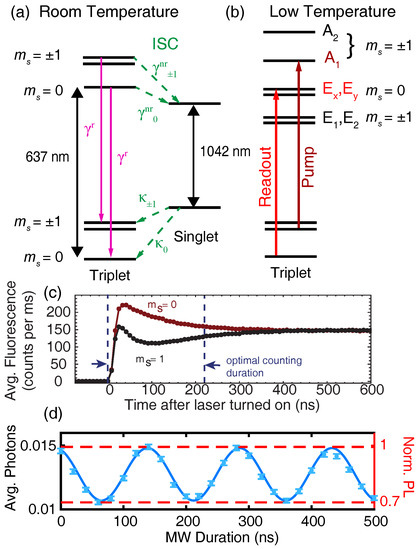
Hopper, D A; Shulevitz, H J; Bassett, L C
Spin readout techniques of the nitrogen-vacancy center in diamond Journal Article
In: Micromachines, vol. 9, pp. 437, 2018.
Abstract | Links | BibTeX | Tags: diamond NV center, spin readout
@article{Hopper2018,
title = {Spin readout techniques of the nitrogen-vacancy center in diamond},
author = {D A Hopper and H J Shulevitz and L C Bassett},
url = {https://www.mdpi.com/2072-666X/9/9/437},
year = {2018},
date = {2018-08-30},
journal = {Micromachines},
volume = {9},
pages = {437},
abstract = {The diamond nitrogen-vacancy (NV) center is a leading platform for quantum information science due to its optical addressability and room-temperature spin coherence. However, measurements of the NV center’s spin state typically require averaging over many cycles to overcome noise. Here, we review several approaches to improve the readout performance and highlight future avenues of research that could enable single-shot electron-spin readout at room temperature.},
keywords = {diamond NV center, spin readout},
pubstate = {published},
tppubtype = {article}
}
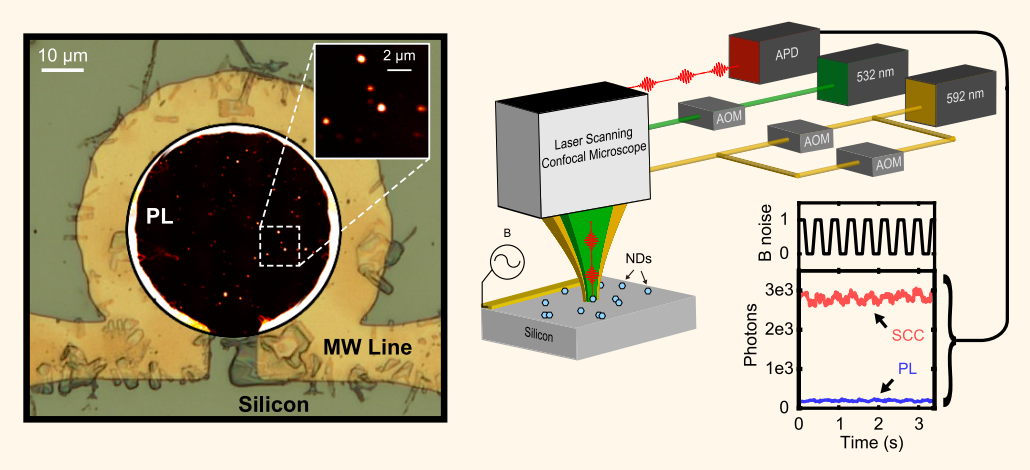
Hopper, D A; Grote, R R; Parks, S M; Bassett, L C
Amplified sensitivity of nitrogen-vacancy spins in nanodiamonds using all-optical charge readout Journal Article
In: ACS Nano, vol. 12, pp. 4678-4686, 2018.
Abstract | Links | BibTeX | Tags: diamond NV center, spin readout
@article{Hopper2018b,
title = {Amplified sensitivity of nitrogen-vacancy spins in nanodiamonds using all-optical charge readout},
author = {D A Hopper and R R Grote and S M Parks and L C Bassett},
url = {https://pubs.acs.org/doi/10.1021/acsnano.8b01265
https://arxiv.org/abs/1712.03882},
year = {2018},
date = {2018-04-13},
journal = {ACS Nano},
volume = {12},
pages = {4678-4686},
abstract = {Nanodiamonds containing nitrogen-vacancy (NV) centers offer a versatile platform for sensing applications spanning from nanomagnetism to in vivo monitoring of cellular processes. In many cases, however, weak optical signals and poor contrast demand long acquisition times that prevent the measurement of environmental dynamics. Here, we demonstrate the ability to perform fast, high-contrast optical measurements of charge distributions in ensembles of NV centers in nanodiamonds and use the technique to improve the spin-readout signal-to-noise ratio through spin-to-charge conversion. A study of 38 nanodiamonds with sizes ranging between 20 and 70 nm, each hosting a small ensemble of NV centers, uncovers complex, multiple time scale dynamics due to radiative and nonradiative ionization and recombination processes. Nonetheless, the NV-containing nanodiamonds universally exhibit charge-dependent photoluminescence contrasts and the potential for enhanced spin readout using spin-to-charge conversion. We use the technique to speed up a T1 relaxometry measurement by a factor of 5.},
keywords = {diamond NV center, spin readout},
pubstate = {published},
tppubtype = {article}
}

Hopper, D A; Grote, R R; Exarhos, A L; Bassett, L C
Near-infrared-assisted charge control and spin readout of the nitrogen-vacancy center in diamond Journal Article
In: Physical Review B, vol. 94, pp. 241201, 2016.
Abstract | Links | BibTeX | Tags: diamond NV center, spin readout
@article{Hopper2016,
title = {Near-infrared-assisted charge control and spin readout of the nitrogen-vacancy center in diamond},
author = {D A Hopper and R R Grote and A L Exarhos and L C Bassett},
url = {https://journals.aps.org/prb/abstract/10.1103/PhysRevB.94.241201},
year = {2016},
date = {2016-12-09},
journal = {Physical Review B},
volume = {94},
pages = {241201},
abstract = {We utilize nonlinear absorption to design all-optical protocols that improve both charge-state initialization and spin readout for the nitrogen-vacancy (NV) center in diamond. Nonmonotonic variations in the equilibrium charge state as a function of visible and near-infrared optical power are attributed to competing multiphoton absorption processes. In certain regimes, multicolor illumination enhances the steady-state population of the NV's negative charge state above 90%. At higher NIR intensities, selective ionization of the singlet manifold facilitates a protocol for spin-to-charge conversion that dramatically enhances the spin readout fidelity. We demonstrate a sixfold increase in the signal-to-noise ratio for single-shot spin measurements and demonstrate a pathway towards single-shot electron spin readout at room temperature.},
keywords = {diamond NV center, spin readout},
pubstate = {published},
tppubtype = {article}
}
2025

Huang, Tzu-Yung; Hopper, David A.; Omirzakhov, Kaisarbek; Idjadi, Mohamad Hossein; Breitweiser, S. Alexander; Aflatouni, Firooz; Bassett, Lee C.
Electronic Noise Considerations for Designing Integrated Solid-State Quantum Memories Journal Article
In: Advanced Quantum Technologies, pp. 2400472, 2025.
@article{Huang2025,
title = {Electronic Noise Considerations for Designing Integrated Solid-State Quantum Memories},
author = {Tzu-Yung Huang and David A. Hopper and Kaisarbek Omirzakhov and Mohamad Hossein Idjadi and S. Alexander Breitweiser and Firooz Aflatouni and Lee C. Bassett},
url = {https://onlinelibrary.wiley.com/doi/10.1002/qute.202400472#
https://arxiv.org/abs/2501.00683},
year = {2025},
date = {2025-02-06},
urldate = {2025-02-06},
journal = {Advanced Quantum Technologies},
pages = {2400472},
abstract = {As quantum networks expand and are deployed outside research laboratories, a need arises to design and integrate compact control electronics for each memory node. It is essential to understand the performance requirements for such systems, especially concerning tolerable levels of noise, since these specifications dramatically affect a system's design complexity and cost. Here, using an approach that can be easily generalized across quantum-hardware platforms, a case study based on nitrogen-vacancy (NV) centers in diamond is presented. The effects of phase noise and timing jitter in the control system in conjunction are modeled and experimentally verified with the spin qubit's environmental noise. The impact of different phase noise characteristics on the fidelity of dynamical decoupling sequences is also considered. The results demonstrate a procedure to specify design requirements for integrated quantum control signal generators for solid-state spin qubits, depending on their coherence time, intrinsic noise spectrum, and required fidelity.},
keywords = {},
pubstate = {published},
tppubtype = {article}
}
2024

Breitweiser, S. Alex; Ouellet, Mathieu; Huang, Tzu-Yung; Taminiau, Tim H.; Bassett, Lee C.
Quadrupolar resonance spectroscopy of individual nuclei using a room-temperature quantum sensor Journal Article
In: Nano Letters, vol. 24, iss. 51, pp. 16253-16260, 2024.
@article{Breitweiser2024,
title = {Quadrupolar resonance spectroscopy of individual nuclei using a room-temperature quantum sensor},
author = {S. Alex Breitweiser and Mathieu Ouellet and Tzu-Yung Huang and Tim H. Taminiau and Lee C. Bassett},
url = {https://pubs.acs.org/doi/abs/10.1021/acs.nanolett.4c04112
https://arxiv.org/abs/2405.14859},
year = {2024},
date = {2024-12-12},
urldate = {2024-12-12},
journal = {Nano Letters},
volume = {24},
issue = {51},
pages = {16253-16260},
abstract = {Nuclear quadrupolar resonance (NQR) spectroscopy reveals chemical bonding patterns in materials and molecules through the unique coupling between nuclear spins and local fields. However, traditional NQR techniques require macroscopic ensembles of nuclei to yield a detectable signal, which obscures molecule-to-molecule variations. Solid-state spin qubits, such as the nitrogen-vacancy (NV) center in diamond, facilitate the detection and control of individual nuclei through their local magnetic couplings. Here, we use NV centers to perform NQR spectroscopy on their associated nitrogen-14 (14N) nuclei at room temperature. In mapping the nuclear quadrupolar Hamiltonian, we resolve minute variations between individual nuclei. The measurements reveal correlations between the Hamiltonian parameters associated with the NV center’s electronic and nuclear spin states, as well as a previously unreported symmetry-breaking quadrupolar term. We further design pulse sequences to initialize, read out, and control the quantum evolution of the 14N nuclear state using the nuclear quadrupolar Hamiltonian.},
keywords = {},
pubstate = {published},
tppubtype = {article}
}

Klein, Amelia R.; Engheta, Nader; Bassett, Lee C.
Designing metasurface optical interfaces for solid-state qubits using many-body adjoint shape optimization Journal Article
In: Optics Express, vol. 32, iss. 22, pp. 38504-38515, 2024.
@article{Klein2024,
title = {Designing metasurface optical interfaces for solid-state qubits using many-body adjoint shape optimization},
author = {Amelia R. Klein and Nader Engheta and Lee C. Bassett},
url = {https://opg.optica.org/oe/fulltext.cfm?uri=oe-32-22-38504&id=561330
https://arxiv.org/abs/2406.08212},
doi = {10.1364/OE.522501},
year = {2024},
date = {2024-10-09},
urldate = {2024-10-09},
journal = {Optics Express},
volume = {32},
issue = {22},
pages = {38504-38515},
abstract = {We present a general strategy for the inverse design of metasurfaces composed of elementary shapes. We use it to design a structure that collects and collimates light from nitrogen-vacancy centers in diamond. Such metasurfaces constitute scalable optical interfaces for solid-state qubits, enabling efficient photon coupling into optical fibers and eliminating free-space collection optics. The many-body shape optimization strategy is a practical alternative to topology optimization that explicitly enforces material and fabrication constraints throughout the optimization, while still achieving high performance. The metasurface is easily adaptable to other solid-state qubits, and the optimization method is broadly applicable to fabrication-constrained photonic design problems.},
keywords = {},
pubstate = {published},
tppubtype = {article}
}

Shulevitz, Henry J.; Amirshaghaghi, Ahmad; Ouellet, Mathieu; Brustoloni, Caroline; Yang, Shengsong; Ng, Jonah J.; Huang, Tzu-Yung; Jishkariani, Davit; Murray, Christopher B.; Tsourkas, Andrew; Kagan, Cherie R.; Bassett, Lee C.
Nanodiamond emulsions for enhanced quantum sensing and click-chemistry conjugation Journal Article
In: ACS Applied Nano Materials, vol. 7, iss. 13, pp. 15334-15343, 2024.
@article{Shulevitz2024,
title = {Nanodiamond emulsions for enhanced quantum sensing and click-chemistry conjugation},
author = {Henry J. Shulevitz and Ahmad Amirshaghaghi and Mathieu Ouellet and Caroline Brustoloni and Shengsong Yang and Jonah J. Ng and Tzu-Yung Huang and Davit Jishkariani and Christopher B. Murray and Andrew Tsourkas and Cherie R. Kagan and Lee C. Bassett},
url = {https://pubs.acs.org/doi/abs/10.1021/acsanm.4c01699
https://arxiv.org/abs/2311.16530},
doi = {10.1021/acsanm.4c01699},
year = {2024},
date = {2024-06-29},
urldate = {2024-06-29},
journal = {ACS Applied Nano Materials},
volume = {7},
issue = {13},
pages = {15334-15343},
abstract = {Nanodiamonds containing nitrogen-vacancy (NV) centers can serve as colloidal quantum sensors of local fields in biological and chemical environments. However, nanodiamond surfaces are challenging to modify without degrading their colloidal stability or the NV center’s optical and spin properties. We present a simple and general method to coat nanodiamonds with a thin emulsion layer that preserves their quantum features, maintains their colloidal stability, and provides functional groups for subsequent cross-linking and click-chemistry conjugation reactions. To demonstrate this technique, we decorated nanodiamonds with combinations of carboxyl- and azide-terminated amphiphiles that enable conjugation using two different strategies. A theoretical model is developed to understand the effect of the emulsion layer on the NV center’s spin lifetime, and T1 relaxometry is employed to quantify the nanodiamonds’ chemical sensitivity to paramagnetic ions. This general approach to nanodiamond surface functionalization will enable advances in quantum nanomedicine and biological sensing.},
keywords = {},
pubstate = {published},
tppubtype = {article}
}

van de Stolpe, G. L.; Kwiatkowski, D. P.; Bradley, C. E.; Randall, J.; Breitweiser, S. A.; Bassett, L. C.; Markham, M.; Twitchen, D. J.; Taminiau, T. H.
Mapping a 50-spin-qubit network through correlated sensing Journal Article
In: Nature Communications , vol. 15, no. 2006, 2024.
@article{vandeStolpe2023,
title = {Mapping a 50-spin-qubit network through correlated sensing},
author = {G.L. van de Stolpe and D. P. Kwiatkowski and C.E. Bradley and J. Randall and S. A. Breitweiser and L. C. Bassett and M. Markham and D.J. Twitchen and T.H. Taminiau},
url = {https://arxiv.org/abs/2307.06939
https://www.nature.com/articles/s41467-024-46075-4},
doi = {10.1038/s41467-024-46075-4},
year = {2024},
date = {2024-03-05},
journal = {Nature Communications },
volume = {15},
number = {2006},
abstract = {Spins associated to optically accessible solid-state defects have emerged as a versatile platform for exploring quantum simulation, quantum sensing and quantum communication. Pioneering experiments have shown the sensing, imaging, and control of multiple nuclear spins surrounding a single electron-spin defect. However, the accessible size and complexity of these spin networks has been constrained by the spectral resolution of current methods. Here, we map a network of 50 coupled spins through high-resolution correlated sensing schemes, using a single nitrogen-vacancy center in diamond. We develop concatenated double-resonance sequences that identify spin-chains through the network. These chains reveal the characteristic spin frequencies and their interconnections with high spectral resolution, and can be fused together to map out the network. Our results provide new opportunities for quantum simulations by increasing the number of available spin qubits. Additionally, our methods might find applications in nano-scale imaging of complex spin systems external to the host crystal.},
keywords = {},
pubstate = {published},
tppubtype = {article}
}
2023

Omirzakhov, Kaisarbek; Idjadi, Mohamad Hossein; Huang, Tzu-Yung; Breitweiser, S. Alex; Hopper, David A.; Bassett, Lee C.; Aflatouni, Firooz
An Integrated Reconfigurable Spin Control System on 180 nm CMOS for Diamond NV Centers Journal Article
In: IEEE Transactions on Microwave Theory and Techniques, pp. 1-12, 2023.
@article{Omirzakhov2023,
title = {An Integrated Reconfigurable Spin Control System on 180 nm CMOS for Diamond NV Centers},
author = {Kaisarbek Omirzakhov and Mohamad Hossein Idjadi and Tzu-Yung Huang and S. Alex Breitweiser and David A. Hopper and Lee C. Bassett and Firooz Aflatouni},
url = {https://ieeexplore.ieee.org/document/10079193/keywords#keywords},
doi = {10.1109/TMTT.2023.3254600},
year = {2023},
date = {2023-03-23},
journal = {IEEE Transactions on Microwave Theory and Techniques},
pages = {1-12},
abstract = {Solid-state electron spins are key building blocks for emerging applications in quantum information science, including quantum computers, quantum communication links, and quantum sensors. These solid-state spins are mainly controlled using complex microwave pulse sequences, which are typically generated using benchtop electrical instruments. Integration of the required electronics will enable realization of a scalable low-power and compact optically addressable quantum system. Here, we report an integrated reconfigurable quantum control system, which is used to find electron-spin resonance (ESR) frequency and perform Rabi, Ramsey, and Hahn-echo measurements for a nitrogen-vacancy (NV) center spin qubit in diamond. The chip can be programmed to synthesize an RF signal tunable from 1.6 to 2.6 GHz, which is modulated with a sequence of up to 4098 reconfigurable pulses with a pulse width and pulse-to-pulse delay adjustable from 10 ns to 42 ms and 18 ns to 42 ms, respectively, at a resolution of 2.5 ns. The 180-nm CMOS chip is fabricated within a footprint of 3.02 mm 2 and has a power consumption of 80 mW.},
keywords = {},
pubstate = {published},
tppubtype = {article}
}
2022

Shulevitz, Henry J.; Huang, Tzu-Yung; Xu, Jun; Neuhaus, Steven; Patel, Raj N.; Lee C. Bassett, Cherie R. Kagan
Template-Assisted Self Assembly of Fluorescent Nanodiamonds for Scalable Quantum Technologies Journal Article
In: ACS Nano, vol. 16, no. 2, pp. 1847–1856, 2022.
@article{Shulevitz2021,
title = {Template-Assisted Self Assembly of Fluorescent Nanodiamonds for Scalable Quantum Technologies},
author = {Henry J. Shulevitz and Tzu-Yung Huang and Jun Xu and Steven Neuhaus and Raj N. Patel and Lee C. Bassett, Cherie R. Kagan},
url = {https://arxiv.org/abs/2111.14921},
doi = {10.1021/acsnano.1c09839},
year = {2022},
date = {2022-01-13},
journal = {ACS Nano},
volume = {16},
number = {2},
pages = {1847–1856},
abstract = {Milled nanodiamonds containing nitrogen-vacancy (NV) centers provide an excellent platform for sensing applications as they are optically robust, have nanoscale quantum sensitivity, and form colloidal dispersions which enable bottom-up assembly techniques for device integration. However, variations in their size, shape, and surface chemistry limit the ability to position individual nanodiamonds and statistically study properties that affect their optical and quantum characteristics. Here, we present a scalable strategy to form ordered arrays of nanodiamonds using capillary-driven, template-assisted self assembly. This method enables the precise spatial arrangement of isolated nanodiamonds with diameters below 50 nm across millimeter-scale areas. Measurements of over 200 assembled nanodiamonds yield a statistical understanding of their structural, optical, and quantum properties. The NV centers' spin and charge properties are uncorrelated with nanodiamond size, but rather are consistent with heterogeneity in their nanoscale environment. This flexible assembly method, together with improved understanding of the material, will enable the integration of nanodiamonds into future quantum photonic and electronic devices.},
keywords = {},
pubstate = {published},
tppubtype = {article}
}
2020

Hopper, D A; Lauigan, J D; Huang, T -Y; Bassett, L C
Real-Time Charge Initialization of Diamond Nitrogen-Vacancy Centers for Enhanced Spin Readout Journal Article
In: Phys. Rev. Applied, vol. 13, pp. 024016, 2020.
@article{Hopper2019,
title = {Real-Time Charge Initialization of Diamond Nitrogen-Vacancy Centers for Enhanced Spin Readout},
author = {D A Hopper and J D Lauigan and T -Y Huang and L C Bassett},
url = {https://arxiv.org/abs/1907.08741
https://journals.aps.org/prapplied/abstract/10.1103/PhysRevApplied.13.024016
https://medium.com/penn-engineering/penn-engineers-ensure-quantum-experiments-get-off-to-the-right-start-bbe6f3382cb},
year = {2020},
date = {2020-02-07},
journal = {Phys. Rev. Applied},
volume = {13},
pages = {024016},
abstract = {Selected as an Editor's Suggestion.
A common impediment to qubit performance is imperfect state initialization. In the case of the diamond nitrogen-vacancy (NV) center, the initialization fidelity is limited by fluctuations in the defect's charge state during optical pumping. Here, we use real-time control to deterministically initialize the NV center's charge state at room temperature. We demonstrate a maximum charge initialization fidelity of 99.4±0.1% and present a quantitative model of the initialization process that allows for systems-level optimization of the spin-readout signal-to-noise ratio. Even accounting for the overhead associated with the initialization sequence, increasing the charge initialization fidelity from the steady-state value of 75% near to unity allows for a factor-of-two speedup in experiments while maintaining the same signal-to-noise-ratio. In combination with high-fidelity readout based on spin-to-charge conversion, real-time initialization enables a factor-of-20 speedup over traditional methods, resulting in an ac magnetic sensitivity of 1.3 nT/Hz1/2 for our single NV-center spin. The real-time control method is immediately beneficial for quantum sensing applications with NV centers as well as probing charge-dependent physics, and it will facilitate protocols for quantum feedback control over multi-qubit systems.},
keywords = {},
pubstate = {published},
tppubtype = {article}
}
A common impediment to qubit performance is imperfect state initialization. In the case of the diamond nitrogen-vacancy (NV) center, the initialization fidelity is limited by fluctuations in the defect's charge state during optical pumping. Here, we use real-time control to deterministically initialize the NV center's charge state at room temperature. We demonstrate a maximum charge initialization fidelity of 99.4±0.1% and present a quantitative model of the initialization process that allows for systems-level optimization of the spin-readout signal-to-noise ratio. Even accounting for the overhead associated with the initialization sequence, increasing the charge initialization fidelity from the steady-state value of 75% near to unity allows for a factor-of-two speedup in experiments while maintaining the same signal-to-noise-ratio. In combination with high-fidelity readout based on spin-to-charge conversion, real-time initialization enables a factor-of-20 speedup over traditional methods, resulting in an ac magnetic sensitivity of 1.3 nT/Hz1/2 for our single NV-center spin. The real-time control method is immediately beneficial for quantum sensing applications with NV centers as well as probing charge-dependent physics, and it will facilitate protocols for quantum feedback control over multi-qubit systems.
2018

Hopper, D A; Shulevitz, H J; Bassett, L C
Spin readout techniques of the nitrogen-vacancy center in diamond Journal Article
In: Micromachines, vol. 9, pp. 437, 2018.
@article{Hopper2018,
title = {Spin readout techniques of the nitrogen-vacancy center in diamond},
author = {D A Hopper and H J Shulevitz and L C Bassett},
url = {https://www.mdpi.com/2072-666X/9/9/437},
year = {2018},
date = {2018-08-30},
journal = {Micromachines},
volume = {9},
pages = {437},
abstract = {The diamond nitrogen-vacancy (NV) center is a leading platform for quantum information science due to its optical addressability and room-temperature spin coherence. However, measurements of the NV center’s spin state typically require averaging over many cycles to overcome noise. Here, we review several approaches to improve the readout performance and highlight future avenues of research that could enable single-shot electron-spin readout at room temperature.},
keywords = {},
pubstate = {published},
tppubtype = {article}
}

Hopper, D A; Grote, R R; Parks, S M; Bassett, L C
Amplified sensitivity of nitrogen-vacancy spins in nanodiamonds using all-optical charge readout Journal Article
In: ACS Nano, vol. 12, pp. 4678-4686, 2018.
@article{Hopper2018b,
title = {Amplified sensitivity of nitrogen-vacancy spins in nanodiamonds using all-optical charge readout},
author = {D A Hopper and R R Grote and S M Parks and L C Bassett},
url = {https://pubs.acs.org/doi/10.1021/acsnano.8b01265
https://arxiv.org/abs/1712.03882},
year = {2018},
date = {2018-04-13},
journal = {ACS Nano},
volume = {12},
pages = {4678-4686},
abstract = {Nanodiamonds containing nitrogen-vacancy (NV) centers offer a versatile platform for sensing applications spanning from nanomagnetism to in vivo monitoring of cellular processes. In many cases, however, weak optical signals and poor contrast demand long acquisition times that prevent the measurement of environmental dynamics. Here, we demonstrate the ability to perform fast, high-contrast optical measurements of charge distributions in ensembles of NV centers in nanodiamonds and use the technique to improve the spin-readout signal-to-noise ratio through spin-to-charge conversion. A study of 38 nanodiamonds with sizes ranging between 20 and 70 nm, each hosting a small ensemble of NV centers, uncovers complex, multiple time scale dynamics due to radiative and nonradiative ionization and recombination processes. Nonetheless, the NV-containing nanodiamonds universally exhibit charge-dependent photoluminescence contrasts and the potential for enhanced spin readout using spin-to-charge conversion. We use the technique to speed up a T1 relaxometry measurement by a factor of 5.},
keywords = {},
pubstate = {published},
tppubtype = {article}
}
2016

Hopper, D A; Grote, R R; Exarhos, A L; Bassett, L C
Near-infrared-assisted charge control and spin readout of the nitrogen-vacancy center in diamond Journal Article
In: Physical Review B, vol. 94, pp. 241201, 2016.
@article{Hopper2016,
title = {Near-infrared-assisted charge control and spin readout of the nitrogen-vacancy center in diamond},
author = {D A Hopper and R R Grote and A L Exarhos and L C Bassett},
url = {https://journals.aps.org/prb/abstract/10.1103/PhysRevB.94.241201},
year = {2016},
date = {2016-12-09},
journal = {Physical Review B},
volume = {94},
pages = {241201},
abstract = {We utilize nonlinear absorption to design all-optical protocols that improve both charge-state initialization and spin readout for the nitrogen-vacancy (NV) center in diamond. Nonmonotonic variations in the equilibrium charge state as a function of visible and near-infrared optical power are attributed to competing multiphoton absorption processes. In certain regimes, multicolor illumination enhances the steady-state population of the NV's negative charge state above 90%. At higher NIR intensities, selective ionization of the singlet manifold facilitates a protocol for spin-to-charge conversion that dramatically enhances the spin readout fidelity. We demonstrate a sixfold increase in the signal-to-noise ratio for single-shot spin measurements and demonstrate a pathway towards single-shot electron spin readout at room temperature.},
keywords = {},
pubstate = {published},
tppubtype = {article}
}
Select publications before 2014
- “All-optical control of a solid-state spin using coherent dark states”, C. G. Yale, B. B. Buckley, D. J. Christle, G. Burkard, F. J. Heremans, L. C. Bassett, and D. D. Awschalom, Proc. Natl. Acad. Sci. USA 110, 7595 (2013).
- “Quantum spintronics: Engineering and manipulating atom-like spins in semiconductors”, D.D. Awschalom, L.C. Bassett, A.S. Dzurak, E.L. Hu and J.R. Petta, Science 339, 1174 (2013).
Related article: “The Future of Quantum Information Processing”, J. Stajic, Science 339, 1163 (2013).
- “Engineering and quantum control of single spins in semiconductors”, D.M. Toyli, L.C. Bassett, B.B. Buckley, G. Calusine and D.D. Awschalom, MRS Bulletin 38, 139 (2013).
- “Engineering shallow spins in diamond with nitrogen delta-doping”, K. Ohno, F. J. Heremans, L. C. Bassett, B. A. Myers, D. M. Toyli, A. C. Bleszynski-Jayich, C. J. Palmstrøm, and D. D. Awschalom, Appl. Phys. Lett. 101, 082413 (2012).
- “Electrical tuning of single nitrogen-vacancy center optical transitions enhanced by photoinduced fields”, L. C. Bassett, F. J. Heremans, C. G. Yale, B. B. Buckley, and D. D. Awschalom, Phys. Rev. Lett. 107, 266403 (2011).
- “Spin-light coherence for single-spin measurement and control in diamond”, B. B. Buckley, G. D. Fuchs, L. C. Bassett, and D. D. Awschalom, Science 330, 1212 (2010).
Related article: “Quantum measurement and control of single spins in diamond”, Science 330, 1188 (2010).
